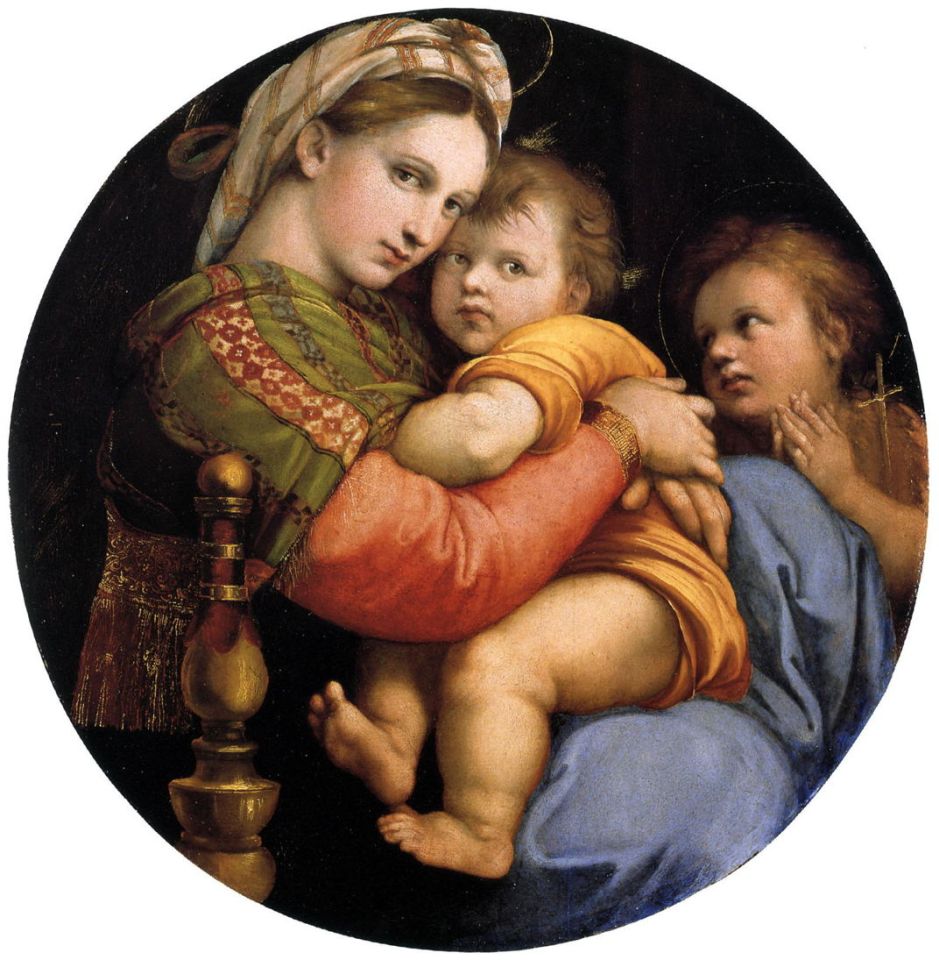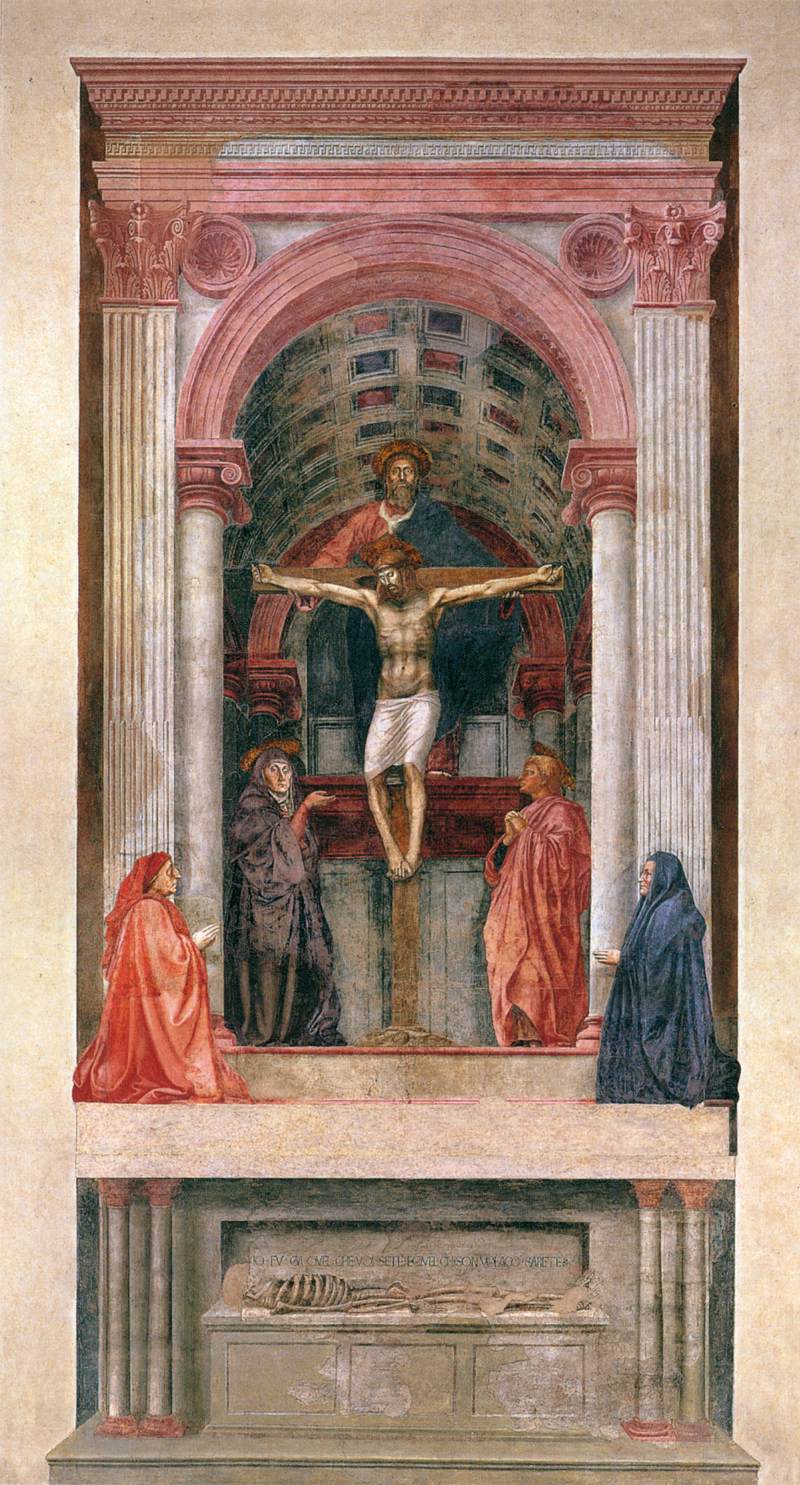Although no one questions the existence of the Renaissance, there’s extensive debate as to when it started. In the south of Europe, it appears to have started at different times in different arts: in literature, it was marked by Dante, whose Divine Comedy was completed in 1320, Petrarch’s Il Canzoniere written between about 1327-68, and Boccacchio’s Decameron completed in 1353, in which case it was in full swing by the latter half of the fourteenth century, when most Italian paintings are still held to be Gothic. As a result, some propose a start date of 1401.
Before we can be any clearer, it’s essential to delineate the changes that took place in painting in the Renaissance, and the best way to see that is to consider three paintings of a common theme, the Madonna and Child.

Cimabué’s Maestà was painted in egg tempera for the main altar of the church of Santa Trinita in Florence, between 1280-90. Little attempt is made to distinguish surface textures, although some use is made of lightness and pattern in fabrics to depict their folds. Faces are uniform and devoid of expression or emotion, most turned in directions determined by its structured composition. There’s no sign of any landscape or other background, and no impression of reality.

While Ghirlandaio’s Madonna and Child from about 1470-75 was still painted in egg tempera, it’s much more realistic in its approach to the figures and the folds in fabrics. Modelling of the figures is still restrained, and there’s no natural background, but its intent is clearly to resemble a real mother and her infant.

Raphael’s Madonna della Sedia (Madonna of the Chair) from 1513-14 shows a thoroughly real and natural mother with two infants, every surface texture rendered as in life, with wisps of hair, differentiation between types of fabric, and convincing expressions and postures.
Many of the changes seen here in the Renaissance can be elaborated as follows:
- surface texture of skin, hair and fabrics;
- individual faces expressing emotions;
- telling stories using body language;
- individual natural posture;
- realistic landscape backgrounds;
- three-dimensional perspective projection with controlled vanishing points;
- varied composition;
- the air of reality;
- use of oil paints;
- increasing production of easel paintings;
- references to secular and classical literature;
- new genres such as landscapes and secular paintings;
- direct patronage;
- independent and secular masters.
Most of those are subjective, and when traced through different paintings by various artists vary widely. Three can be investigated more formally, though: perspective projection, use of oil paints, and the appearance of secular genres such as landscapes. I will look in more detail at the first two in subsequent articles, but for our current purposes I here propose dates.
Surprisingly, there’s still some dispute as to when perspective projection was introduced to painting, some even claiming that this happened in classical Roman times.

Confusion continues, with others claiming that the Sienese and Florentine master Ambrogio Lorenzetti used geometrically correct projection in his late paintings. Formal analysis of those, and this earlier Presentation in the Temple from 1342, confirm that those paintings have multiple and incoherent vanishing points. His use of a geometric pattern in the floor may give the impression that it has been projected in accordance with principles which weren’t known until Brunelleschi discovered them in about 1420, but this wasn’t uncommon.

The earliest surviving painting in which Brunelleschi’s principles were fully utilised to create a rigorously correct projection with one vanishing point is Masaccio’s Holy Trinity, which he completed no earlier than 1426, and no later than 1428, when he died in Rome.
If you make correct perspective projection a criterion for Renaissance painting, then its starting date cannot be before 1420, well before the introduction of oil paints to Italy.
The early history of oil painting in Italy is a bit more murky. Its first recorded practitioner appears to be Niccolò Antonio Colantonio, who was using the new paints, almost certainly brought from the Northern Renaissance, in about 1445. However, Colantonio’s own paintings were obscure, and the medium only achieved fame at the hand of Antonello da Messina, who was probably taught by Colantonio.

Antonello’s Saint Jerome in his Study is perhaps his first real masterpiece. Heavily influenced by the northern European paintings which he must have seen, this was painted in oils to their same high standard. Rather than using linseed oil as its binder, analysis has shown that it used walnut oil. This flies in the face of what is usually written about drying oil usage in Italy at this time: walnut oil is said to have been preferred for lighter pigments, because it discolours less on drying than linseed oil. In this painting, that reason for using walnut oil doesn’t appear to be convincing.
This painting has an unusually long provenance too, being first recorded in 1529, before making its way to Rome. When it went to Britain later, it was originally attributed to Dürer before it was bought by the National Gallery in 1894 and finally recognised as one of Antonello’s.
Although Antonello died suddenly in 1479, in the few years between 1475-79 he worked in Venice and achieved fame for his oil paintings. As late as 1500, Italian masters were still using egg tempera as their preferred medium for easel paintings.
One of the early and most skilled practitioners of oil painting was another brilliant but short-lived master, the Venetian Giorgione, who has the added distinction of painting what was probably the first landscape painting of the southern Renaissance.

Giorgione’s revolutionary landscape The Tempest from just after 1500 remains enigmatic today, and may have religious references, but it marked the start of a new and wholly secular genre.
The earliest dates for those fairly objective landmarks which distinguish Renaissance painting are thus 1420, 1475, and 1504. They not only emphasise how late painting changed compared with literature, but show how the Renaissance wasn’t a sudden event, but an evolution which proceeded over a period of about a century. In the next article, I’ll consider perspective projection in more detail, and the role of Florence in Renaissance painting.

